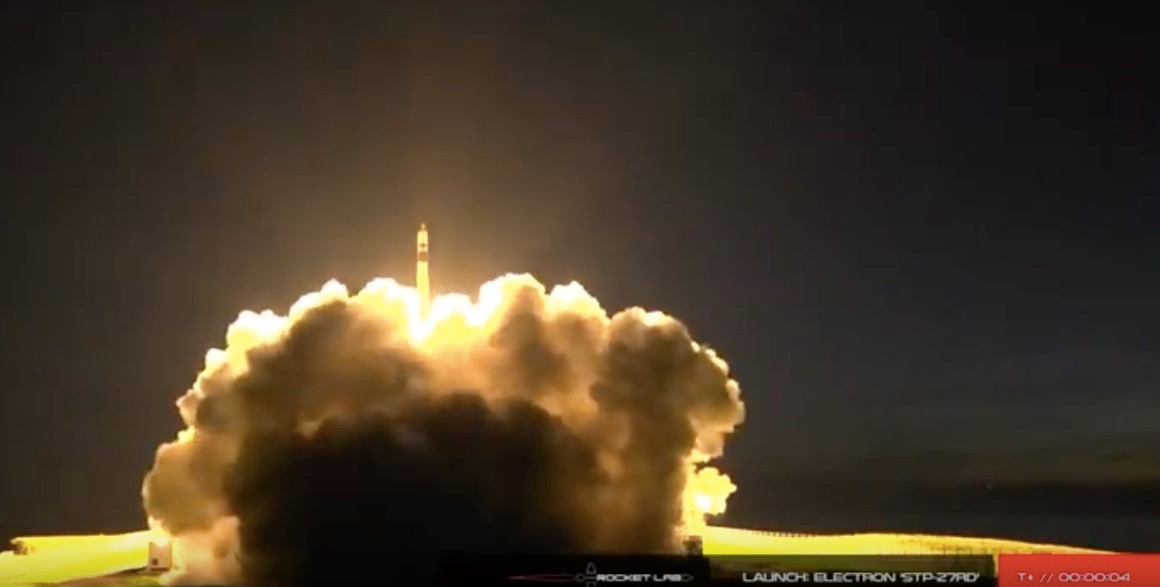Rocket Lab successfully launched three experimental satellites for the U.S. Air Force today (May 5), acing the company's second Department of Defense mission in five weeks.
Rocket Lab's Electron booster lifted off from the company's New Zealand launch site at 2 a.m. EDT (0600 GMT, or 6 p.m. local New Zealand time) and delivered two cubesats and a larger craft to their assigned slots in Earth orbit less than an hour later.
Together, the three satellites weigh more than 397 lbs. (180 kilograms), the heaviest load that the 57-foot-tall (17 meters) Electron has ever toted, Rocket Lab representatives said.
Related: In Photos: Rocket Lab and Its Electron Booster
Perfect flight, complete mission success, all payloads deployed!!May 5, 2019
One of the cubesats, the Falcon Orbital Debris Experiment (Falcon ODE), will help researchers evaluate the effectiveness of ground-based systems for tracking space junk. The other, the Space Plug-and-Play Architecture Research Cubesat-1 (SPARC-1), will test the performance of supersmall avionics and other gear.
"It's really seeing how small and functional some of this stuff can be," Rocket Lab CEO Peter Beck told Space.com last month, referring to SPARC-1.

The other satellite, called Harbinger, makes up most of the trio's total mass. Harbinger "is a commercial small satellite built by York Space Systems that will demonstrate the ability of an experimental commercial system to meet government space-capability requirements," Rocket Lab representatives wrote in a description of today's mission, which is officially called STP-27RD.
Get the Space.com Newsletter
Breaking space news, the latest updates on rocket launches, skywatching events and more!
That acronym refers to the customer, the Air Force's Space Test Program, and the research-and-development function of all three satellites. (Rocket Lab tends to name its rockets as well. The one that flew today was called "That's a Funny Looking Cactus," a nod to the high-desert roots of the Space Test Program, which is based at Kirtland Air Force Base in Albuquerque, New Mexico.)
Today's launch was the sixth overall for the two-stage Electron, including test flights, and the rocket's second of 2019. In late March, the Electron lofted a spacecraft called R3D2 for the U.S. Defense Advanced Research Projects Agency (DARPA). R3D2 is also an experimental satellite; the craft aims to demonstrate an ultrathin antenna that could boost the communications capabilities of small spacecraft.
If everything goes according to plan, Electrons will soon fly more frequently. Rocket Lab aims to launch a dozen missions this year, Beck has said.
Over the long haul, Rocket Lab would like to fly once per week, or perhaps even more frequently. The company's chief goal is to dramatically increase access to space using the expendable Electron, which can deliver 500 lbs. (225 kg) of payload to orbit on each roughly $5 million liftoff.
Not all of these missions will lift off from New Zealand. California-based Rocket Lab is developing a second launch site, at the Mid-Atlantic Regional Spaceport in Virginia, and plans to get it up and running before the end of 2019.
The Falcon ODE cubesat is sponsored by the U.S. Air Force Academy. SPARC-1 is a U.S.-Swedish project sponsored by the U.S. Air Force Research Laboratory's Space Vehicles Directorate, and Harbinger is sponsored by the U.S. Army, Rocket Lab representatives said.
Today's launch was originally scheduled to occur yesterday (May 4), but Rocket Lab pushed it back a day to perform additional checks on the satellites.
- Rocket Lab Aims to Win Cubesat-Launching Race
- It's Business Time! Rocket Lab Lofts 6 Satellites on 1st Commercial Launch
- Cubesats: Tiny, Versatile Spacecraft Explained (Infographic)
Mike Wall's book about the search for alien life, "Out There" (Grand Central Publishing, 2018; illustrated by Karl Tate), is out now. Follow him on Twitter @michaeldwall. Follow us on Twitter @Spacedotcom or Facebook.
Join our Space Forums to keep talking space on the latest missions, night sky and more! And if you have a news tip, correction or comment, let us know at: community@space.com.

Michael Wall is a Senior Space Writer with Space.com and joined the team in 2010. He primarily covers exoplanets, spaceflight and military space, but has been known to dabble in the space art beat. His book about the search for alien life, "Out There," was published on Nov. 13, 2018. Before becoming a science writer, Michael worked as a herpetologist and wildlife biologist. He has a Ph.D. in evolutionary biology from the University of Sydney, Australia, a bachelor's degree from the University of Arizona, and a graduate certificate in science writing from the University of California, Santa Cruz. To find out what his latest project is, you can follow Michael on Twitter.









